Group and Organizational Behavior Analysis: UltraTech Cement
VerifiedAdded on 2023/03/21
|17
|4478
|30
Report
AI Summary
This report provides an in-depth analysis of organizational behavior at UltraTech Cement, focusing on organizational culture and leadership. It examines the company's history, tracing its evolution and the influence of its founders on the prevailing culture. The report delves into the key components of organizational culture, including the impact of sub-cultures, the challenges of change management, and the significance of organizational climate. Furthermore, it assesses the leadership styles employed at UltraTech, considering aspects such as vision communication, change management, and the application of path-goal leadership theory. The analysis explores the interrelation between organizational culture and leadership, highlighting their combined effect on UltraTech's performance and the quality of work life for its employees. The report concludes by suggesting behavioral changes to enhance the company's overall performance and effectiveness, drawing on the insights gained from the analysis.
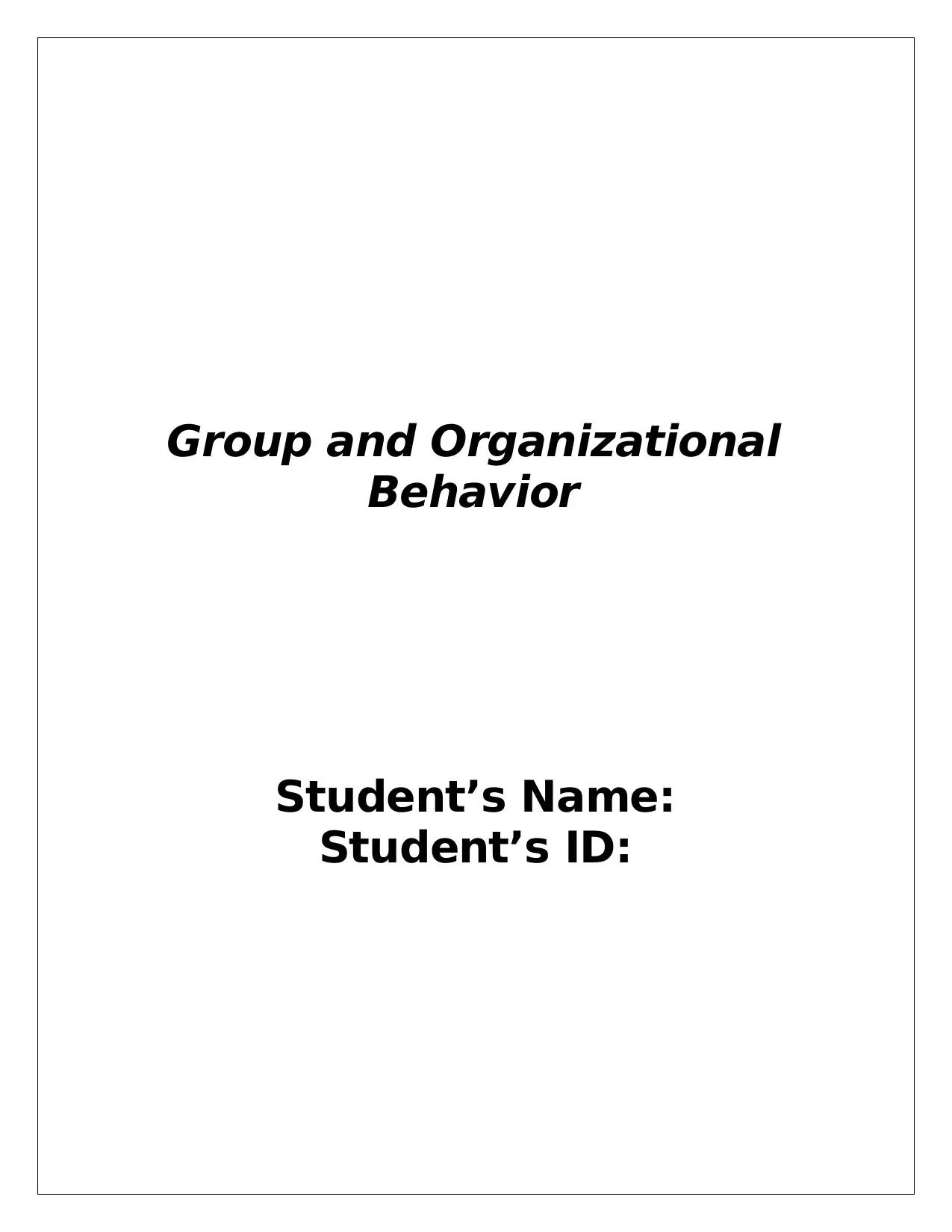
Group and Organizational
Behavior
Student’s Name:
Student’s ID:
Behavior
Student’s Name:
Student’s ID:
Paraphrase This Document
Need a fresh take? Get an instant paraphrase of this document with our AI Paraphraser
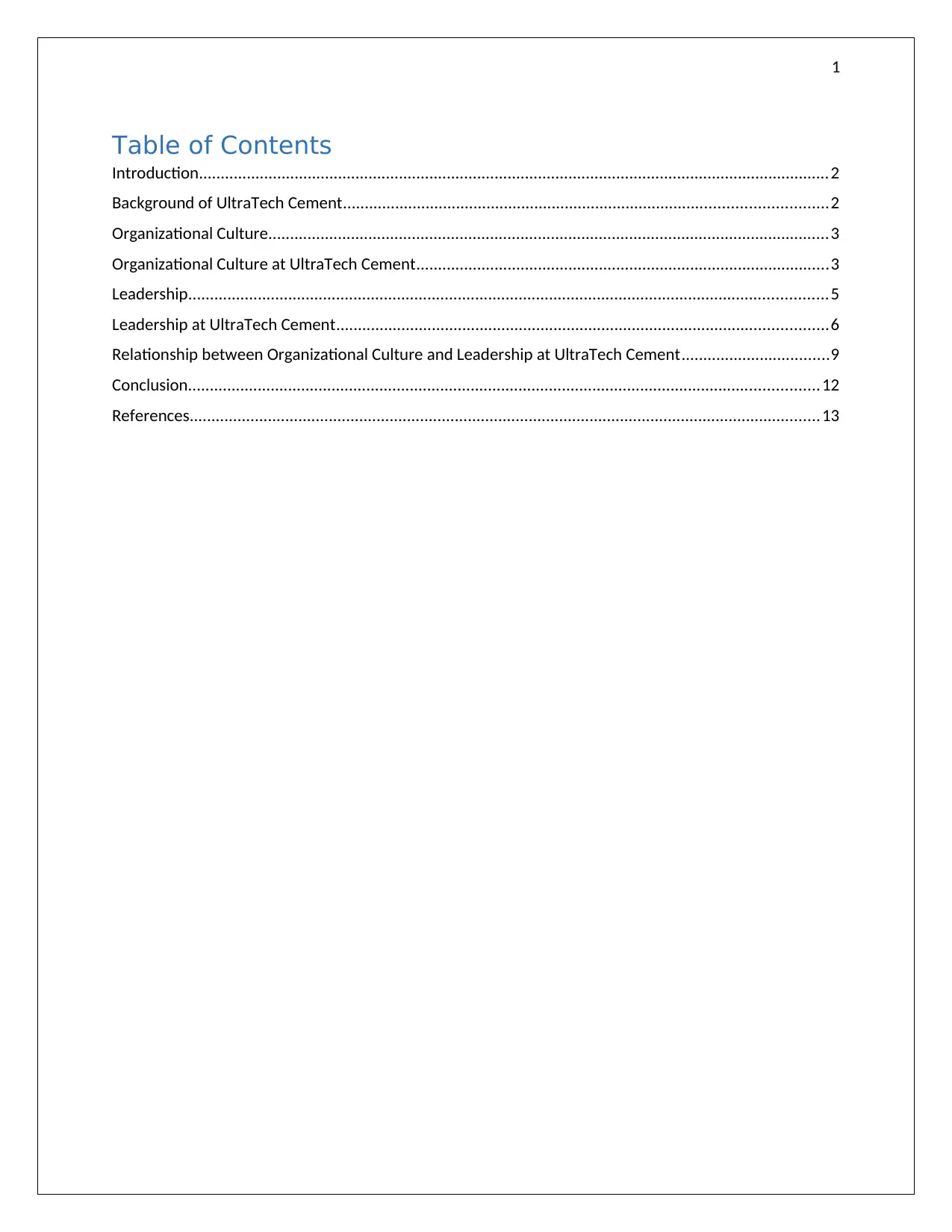
1
Table of Contents
Introduction.................................................................................................................................................2
Background of UltraTech Cement...............................................................................................................2
Organizational Culture.................................................................................................................................3
Organizational Culture at UltraTech Cement...............................................................................................3
Leadership...................................................................................................................................................5
Leadership at UltraTech Cement.................................................................................................................6
Relationship between Organizational Culture and Leadership at UltraTech Cement..................................9
Conclusion.................................................................................................................................................12
References.................................................................................................................................................13
Table of Contents
Introduction.................................................................................................................................................2
Background of UltraTech Cement...............................................................................................................2
Organizational Culture.................................................................................................................................3
Organizational Culture at UltraTech Cement...............................................................................................3
Leadership...................................................................................................................................................5
Leadership at UltraTech Cement.................................................................................................................6
Relationship between Organizational Culture and Leadership at UltraTech Cement..................................9
Conclusion.................................................................................................................................................12
References.................................................................................................................................................13

2
Introduction
The paper will consider two aspects of organizational behavior, organizational culture,
and leadership. It will critically evaluate these two concepts in terms of its capacity of
UltraTech Cement, which is the company where I am currently a member and active
within. It will also determine both the performance and the quality of work life for the
participants of the company. The interrelatedness of leadership like leadership style,
communicating and enhancing visions and change management will be analyzed. The
interrelatedness of organizational culture like the influence of founders, the importance
of sub-cultures, culture as a barrier to changes, and organizational climate will be
evaluated. It will also inter-relate these two concepts in the dynamic and causal way and
will shape the nature of UltraTech Cement. Moreover, it will suggest some behavioral
changes for improving the performance of UltraTech Cement.
Background of UltraTech Cement
UltraTech Cement was founded almost 19 years ago as Larsen & Toubro in the year
2000 as a producer of cement. It was renamed in the year 2004, and currently, it is one
of the top manufacturers of cement all over the world. It is the part of Aditya Birla Group
and the founder of the company held the position of a senior leader since UltraTech had
begun its operations (Bortolotti, Boscari & Danese, 2015). Some of the members of his
family are in the leadership team. Most of the members of the company are part of it for
a long period of time, beside me, who have been invited for joining the leadership team
within one year of joining the company.
Introduction
The paper will consider two aspects of organizational behavior, organizational culture,
and leadership. It will critically evaluate these two concepts in terms of its capacity of
UltraTech Cement, which is the company where I am currently a member and active
within. It will also determine both the performance and the quality of work life for the
participants of the company. The interrelatedness of leadership like leadership style,
communicating and enhancing visions and change management will be analyzed. The
interrelatedness of organizational culture like the influence of founders, the importance
of sub-cultures, culture as a barrier to changes, and organizational climate will be
evaluated. It will also inter-relate these two concepts in the dynamic and causal way and
will shape the nature of UltraTech Cement. Moreover, it will suggest some behavioral
changes for improving the performance of UltraTech Cement.
Background of UltraTech Cement
UltraTech Cement was founded almost 19 years ago as Larsen & Toubro in the year
2000 as a producer of cement. It was renamed in the year 2004, and currently, it is one
of the top manufacturers of cement all over the world. It is the part of Aditya Birla Group
and the founder of the company held the position of a senior leader since UltraTech had
begun its operations (Bortolotti, Boscari & Danese, 2015). Some of the members of his
family are in the leadership team. Most of the members of the company are part of it for
a long period of time, beside me, who have been invited for joining the leadership team
within one year of joining the company.
⊘ This is a preview!⊘
Do you want full access?
Subscribe today to unlock all pages.

Trusted by 1+ million students worldwide
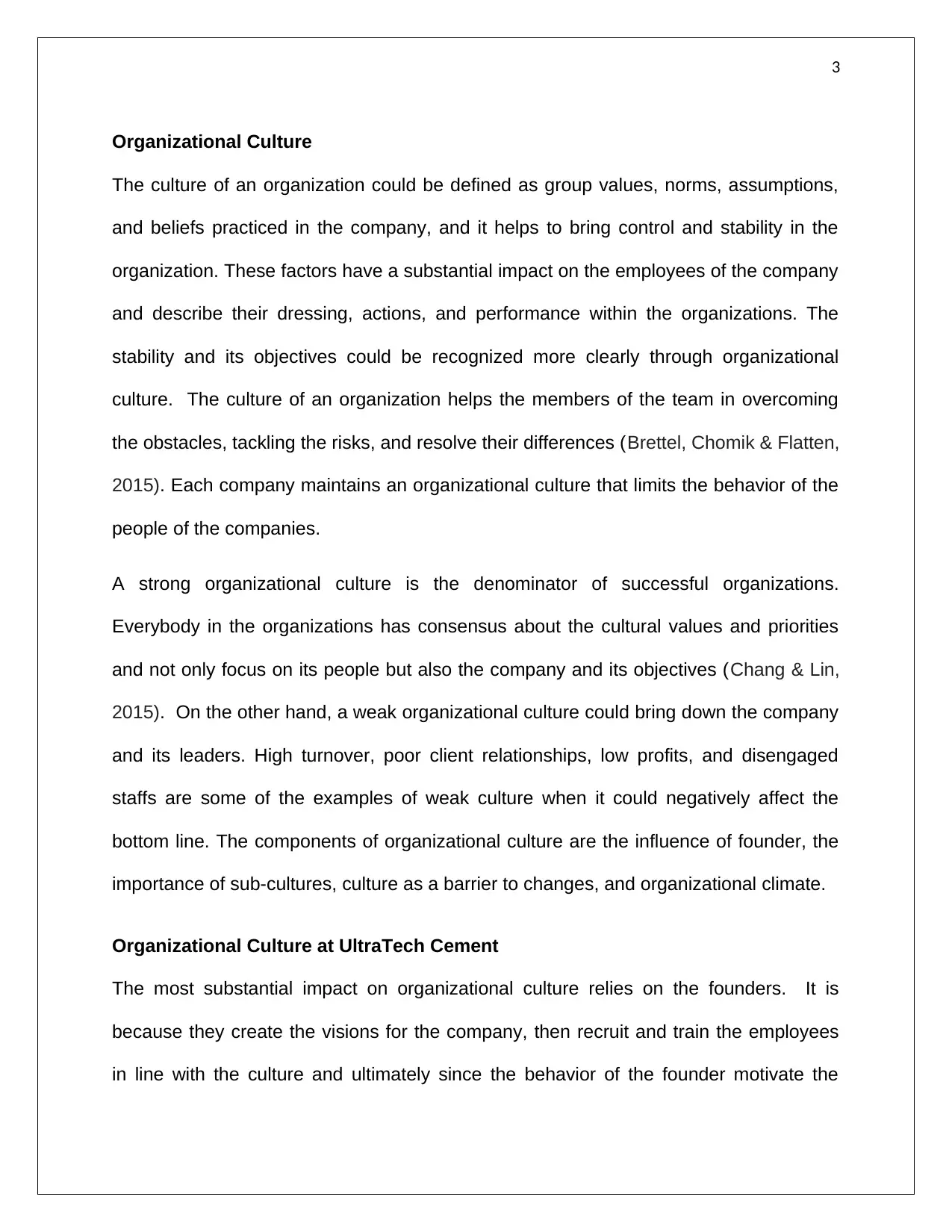
3
Organizational Culture
The culture of an organization could be defined as group values, norms, assumptions,
and beliefs practiced in the company, and it helps to bring control and stability in the
organization. These factors have a substantial impact on the employees of the company
and describe their dressing, actions, and performance within the organizations. The
stability and its objectives could be recognized more clearly through organizational
culture. The culture of an organization helps the members of the team in overcoming
the obstacles, tackling the risks, and resolve their differences (Brettel, Chomik & Flatten,
2015). Each company maintains an organizational culture that limits the behavior of the
people of the companies.
A strong organizational culture is the denominator of successful organizations.
Everybody in the organizations has consensus about the cultural values and priorities
and not only focus on its people but also the company and its objectives (Chang & Lin,
2015). On the other hand, a weak organizational culture could bring down the company
and its leaders. High turnover, poor client relationships, low profits, and disengaged
staffs are some of the examples of weak culture when it could negatively affect the
bottom line. The components of organizational culture are the influence of founder, the
importance of sub-cultures, culture as a barrier to changes, and organizational climate.
Organizational Culture at UltraTech Cement
The most substantial impact on organizational culture relies on the founders. It is
because they create the visions for the company, then recruit and train the employees
in line with the culture and ultimately since the behavior of the founder motivate the
Organizational Culture
The culture of an organization could be defined as group values, norms, assumptions,
and beliefs practiced in the company, and it helps to bring control and stability in the
organization. These factors have a substantial impact on the employees of the company
and describe their dressing, actions, and performance within the organizations. The
stability and its objectives could be recognized more clearly through organizational
culture. The culture of an organization helps the members of the team in overcoming
the obstacles, tackling the risks, and resolve their differences (Brettel, Chomik & Flatten,
2015). Each company maintains an organizational culture that limits the behavior of the
people of the companies.
A strong organizational culture is the denominator of successful organizations.
Everybody in the organizations has consensus about the cultural values and priorities
and not only focus on its people but also the company and its objectives (Chang & Lin,
2015). On the other hand, a weak organizational culture could bring down the company
and its leaders. High turnover, poor client relationships, low profits, and disengaged
staffs are some of the examples of weak culture when it could negatively affect the
bottom line. The components of organizational culture are the influence of founder, the
importance of sub-cultures, culture as a barrier to changes, and organizational climate.
Organizational Culture at UltraTech Cement
The most substantial impact on organizational culture relies on the founders. It is
because they create the visions for the company, then recruit and train the employees
in line with the culture and ultimately since the behavior of the founder motivate the
Paraphrase This Document
Need a fresh take? Get an instant paraphrase of this document with our AI Paraphraser

4
staffs to recognize with them and adopt their values, assumptions, and beliefs
(Effelsberg & Solga, 2015). When a company becomes successful, the personality of
the founders gets embedded in the organizational culture of the companies. Since the
founder of UltraTech has been the senior leader in the company for 19 years, and have
great personality and opinions, his views, personality, and values have become the
basis of culture at UltraTech (Feng, Huang & Zhang, 2016).
The culture at UltraTech is strong and dominant, but several subcultures influence the
company. Each team at UltraTech has different sub-culture due to substantial diversity
in their roles that includes from providing education to the children living in the
community to providing food and clothes to the people in emergency crisis. But, the high
level of competitiveness between the departments strengthens the sub-cultures
(Graham, Ziegert & Capitano, 2015). It has taken place due to less focus on the
performance of UltraTech as a whole and more concentration on the performance of
individuals in the team and comparison with other groups. It could have been
counterproductive for the full performance of the company where there were several
occasions where UltraTech would have gained more profits as a whole rather than an
interdependent approach (Kanfer & Chen, 2016).
A strong culture can become a weak organizational culture that could bring down the
company and its leaders. High turnover, poor client relationships, low profits, and
disengaged staffs are some of the examples of weak culture. As for instance, the
traditional methods of operations were no longer working effectively as found by
quantitative analysis like the decline in profits and feedback. A strong organizational
culture is the denominator of successful organizations (Kim, Eisenberger & Baik, 2016).
staffs to recognize with them and adopt their values, assumptions, and beliefs
(Effelsberg & Solga, 2015). When a company becomes successful, the personality of
the founders gets embedded in the organizational culture of the companies. Since the
founder of UltraTech has been the senior leader in the company for 19 years, and have
great personality and opinions, his views, personality, and values have become the
basis of culture at UltraTech (Feng, Huang & Zhang, 2016).
The culture at UltraTech is strong and dominant, but several subcultures influence the
company. Each team at UltraTech has different sub-culture due to substantial diversity
in their roles that includes from providing education to the children living in the
community to providing food and clothes to the people in emergency crisis. But, the high
level of competitiveness between the departments strengthens the sub-cultures
(Graham, Ziegert & Capitano, 2015). It has taken place due to less focus on the
performance of UltraTech as a whole and more concentration on the performance of
individuals in the team and comparison with other groups. It could have been
counterproductive for the full performance of the company where there were several
occasions where UltraTech would have gained more profits as a whole rather than an
interdependent approach (Kanfer & Chen, 2016).
A strong culture can become a weak organizational culture that could bring down the
company and its leaders. High turnover, poor client relationships, low profits, and
disengaged staffs are some of the examples of weak culture. As for instance, the
traditional methods of operations were no longer working effectively as found by
quantitative analysis like the decline in profits and feedback. A strong organizational
culture is the denominator of successful organizations (Kim, Eisenberger & Baik, 2016).
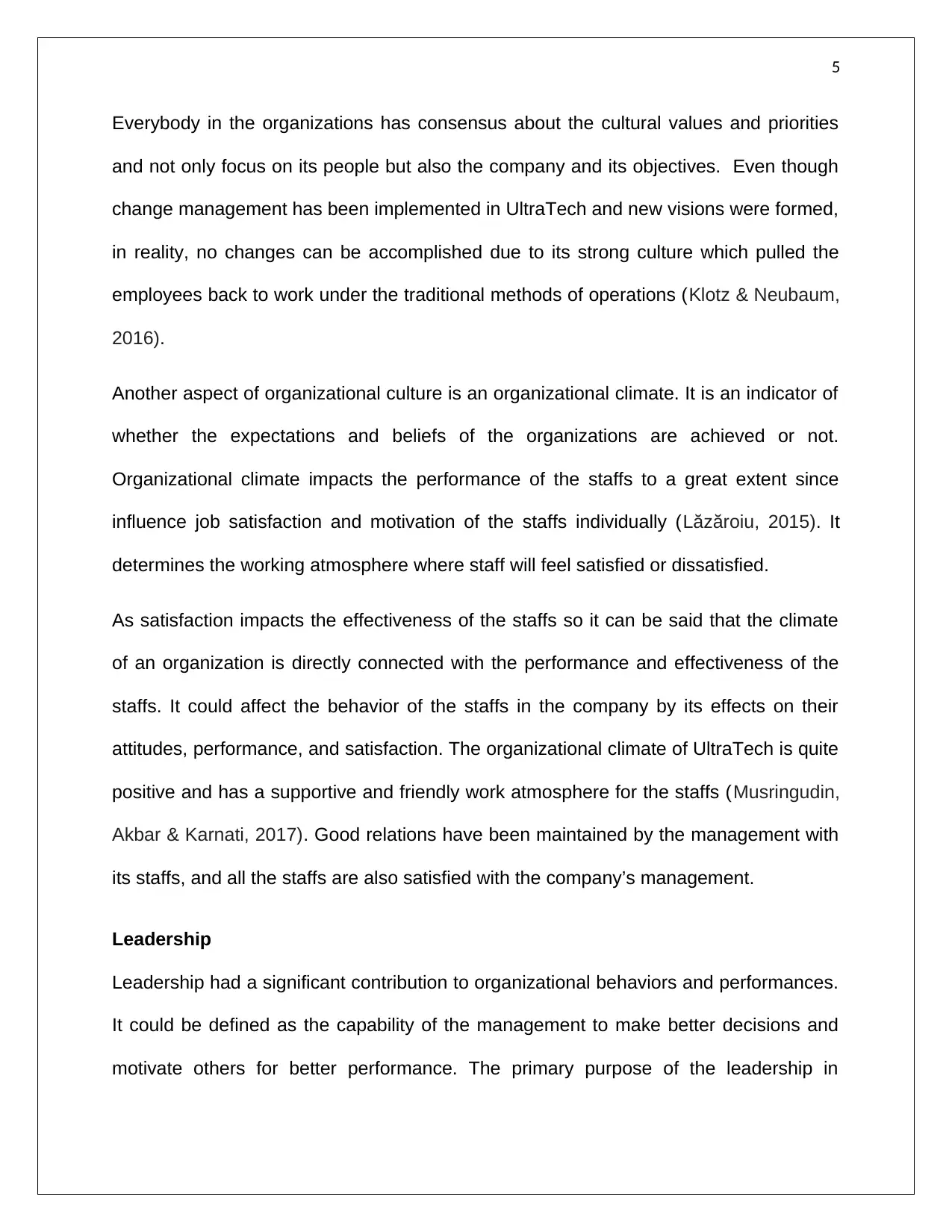
5
Everybody in the organizations has consensus about the cultural values and priorities
and not only focus on its people but also the company and its objectives. Even though
change management has been implemented in UltraTech and new visions were formed,
in reality, no changes can be accomplished due to its strong culture which pulled the
employees back to work under the traditional methods of operations (Klotz & Neubaum,
2016).
Another aspect of organizational culture is an organizational climate. It is an indicator of
whether the expectations and beliefs of the organizations are achieved or not.
Organizational climate impacts the performance of the staffs to a great extent since
influence job satisfaction and motivation of the staffs individually (Lăzăroiu, 2015). It
determines the working atmosphere where staff will feel satisfied or dissatisfied.
As satisfaction impacts the effectiveness of the staffs so it can be said that the climate
of an organization is directly connected with the performance and effectiveness of the
staffs. It could affect the behavior of the staffs in the company by its effects on their
attitudes, performance, and satisfaction. The organizational climate of UltraTech is quite
positive and has a supportive and friendly work atmosphere for the staffs (Musringudin,
Akbar & Karnati, 2017). Good relations have been maintained by the management with
its staffs, and all the staffs are also satisfied with the company’s management.
Leadership
Leadership had a significant contribution to organizational behaviors and performances.
It could be defined as the capability of the management to make better decisions and
motivate others for better performance. The primary purpose of the leadership in
Everybody in the organizations has consensus about the cultural values and priorities
and not only focus on its people but also the company and its objectives. Even though
change management has been implemented in UltraTech and new visions were formed,
in reality, no changes can be accomplished due to its strong culture which pulled the
employees back to work under the traditional methods of operations (Klotz & Neubaum,
2016).
Another aspect of organizational culture is an organizational climate. It is an indicator of
whether the expectations and beliefs of the organizations are achieved or not.
Organizational climate impacts the performance of the staffs to a great extent since
influence job satisfaction and motivation of the staffs individually (Lăzăroiu, 2015). It
determines the working atmosphere where staff will feel satisfied or dissatisfied.
As satisfaction impacts the effectiveness of the staffs so it can be said that the climate
of an organization is directly connected with the performance and effectiveness of the
staffs. It could affect the behavior of the staffs in the company by its effects on their
attitudes, performance, and satisfaction. The organizational climate of UltraTech is quite
positive and has a supportive and friendly work atmosphere for the staffs (Musringudin,
Akbar & Karnati, 2017). Good relations have been maintained by the management with
its staffs, and all the staffs are also satisfied with the company’s management.
Leadership
Leadership had a significant contribution to organizational behaviors and performances.
It could be defined as the capability of the management to make better decisions and
motivate others for better performance. The primary purpose of the leadership in
⊘ This is a preview!⊘
Do you want full access?
Subscribe today to unlock all pages.

Trusted by 1+ million students worldwide
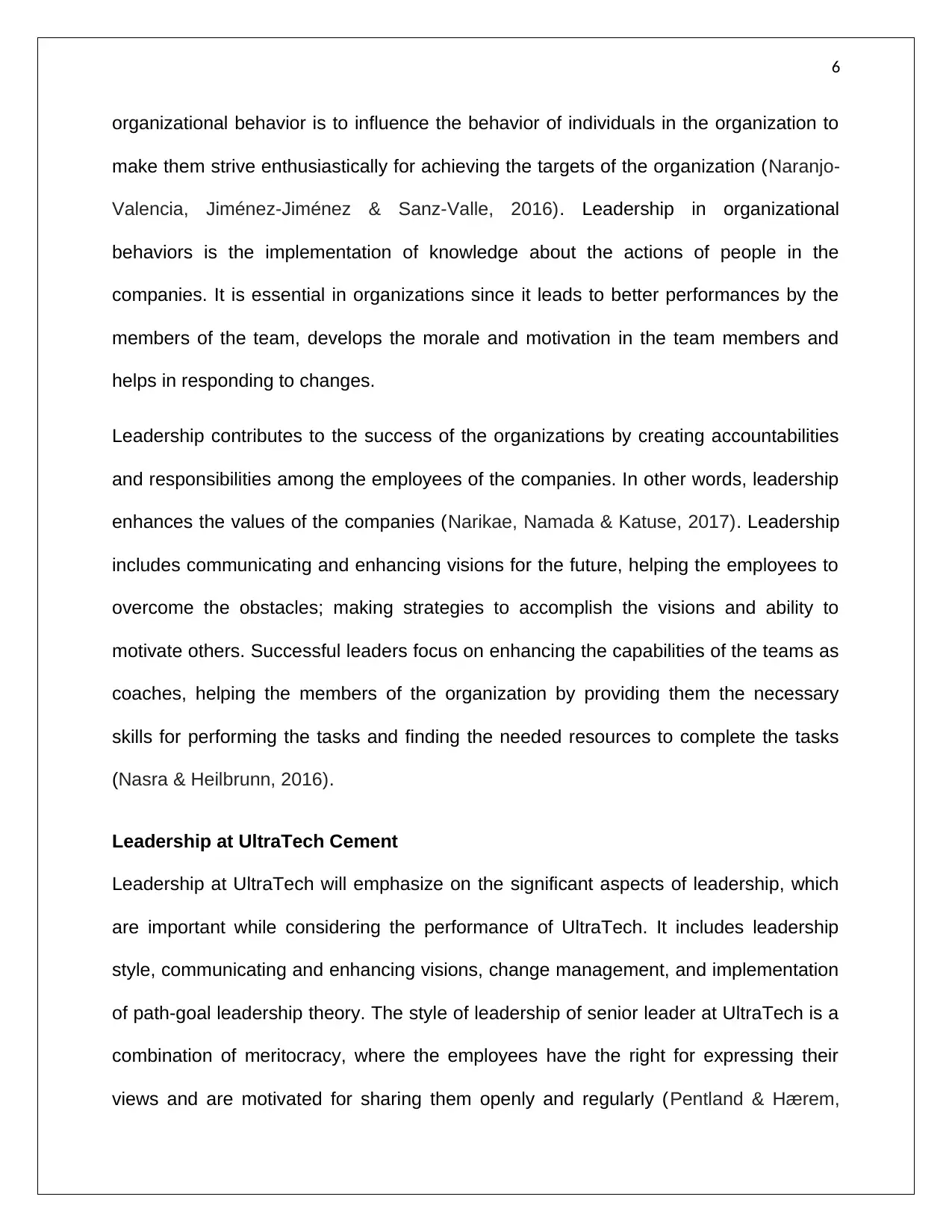
6
organizational behavior is to influence the behavior of individuals in the organization to
make them strive enthusiastically for achieving the targets of the organization (Naranjo-
Valencia, Jiménez-Jiménez & Sanz-Valle, 2016). Leadership in organizational
behaviors is the implementation of knowledge about the actions of people in the
companies. It is essential in organizations since it leads to better performances by the
members of the team, develops the morale and motivation in the team members and
helps in responding to changes.
Leadership contributes to the success of the organizations by creating accountabilities
and responsibilities among the employees of the companies. In other words, leadership
enhances the values of the companies (Narikae, Namada & Katuse, 2017). Leadership
includes communicating and enhancing visions for the future, helping the employees to
overcome the obstacles; making strategies to accomplish the visions and ability to
motivate others. Successful leaders focus on enhancing the capabilities of the teams as
coaches, helping the members of the organization by providing them the necessary
skills for performing the tasks and finding the needed resources to complete the tasks
(Nasra & Heilbrunn, 2016).
Leadership at UltraTech Cement
Leadership at UltraTech will emphasize on the significant aspects of leadership, which
are important while considering the performance of UltraTech. It includes leadership
style, communicating and enhancing visions, change management, and implementation
of path-goal leadership theory. The style of leadership of senior leader at UltraTech is a
combination of meritocracy, where the employees have the right for expressing their
views and are motivated for sharing them openly and regularly (Pentland & Hærem,
organizational behavior is to influence the behavior of individuals in the organization to
make them strive enthusiastically for achieving the targets of the organization (Naranjo-
Valencia, Jiménez-Jiménez & Sanz-Valle, 2016). Leadership in organizational
behaviors is the implementation of knowledge about the actions of people in the
companies. It is essential in organizations since it leads to better performances by the
members of the team, develops the morale and motivation in the team members and
helps in responding to changes.
Leadership contributes to the success of the organizations by creating accountabilities
and responsibilities among the employees of the companies. In other words, leadership
enhances the values of the companies (Narikae, Namada & Katuse, 2017). Leadership
includes communicating and enhancing visions for the future, helping the employees to
overcome the obstacles; making strategies to accomplish the visions and ability to
motivate others. Successful leaders focus on enhancing the capabilities of the teams as
coaches, helping the members of the organization by providing them the necessary
skills for performing the tasks and finding the needed resources to complete the tasks
(Nasra & Heilbrunn, 2016).
Leadership at UltraTech Cement
Leadership at UltraTech will emphasize on the significant aspects of leadership, which
are important while considering the performance of UltraTech. It includes leadership
style, communicating and enhancing visions, change management, and implementation
of path-goal leadership theory. The style of leadership of senior leader at UltraTech is a
combination of meritocracy, where the employees have the right for expressing their
views and are motivated for sharing them openly and regularly (Pentland & Hærem,
Paraphrase This Document
Need a fresh take? Get an instant paraphrase of this document with our AI Paraphraser
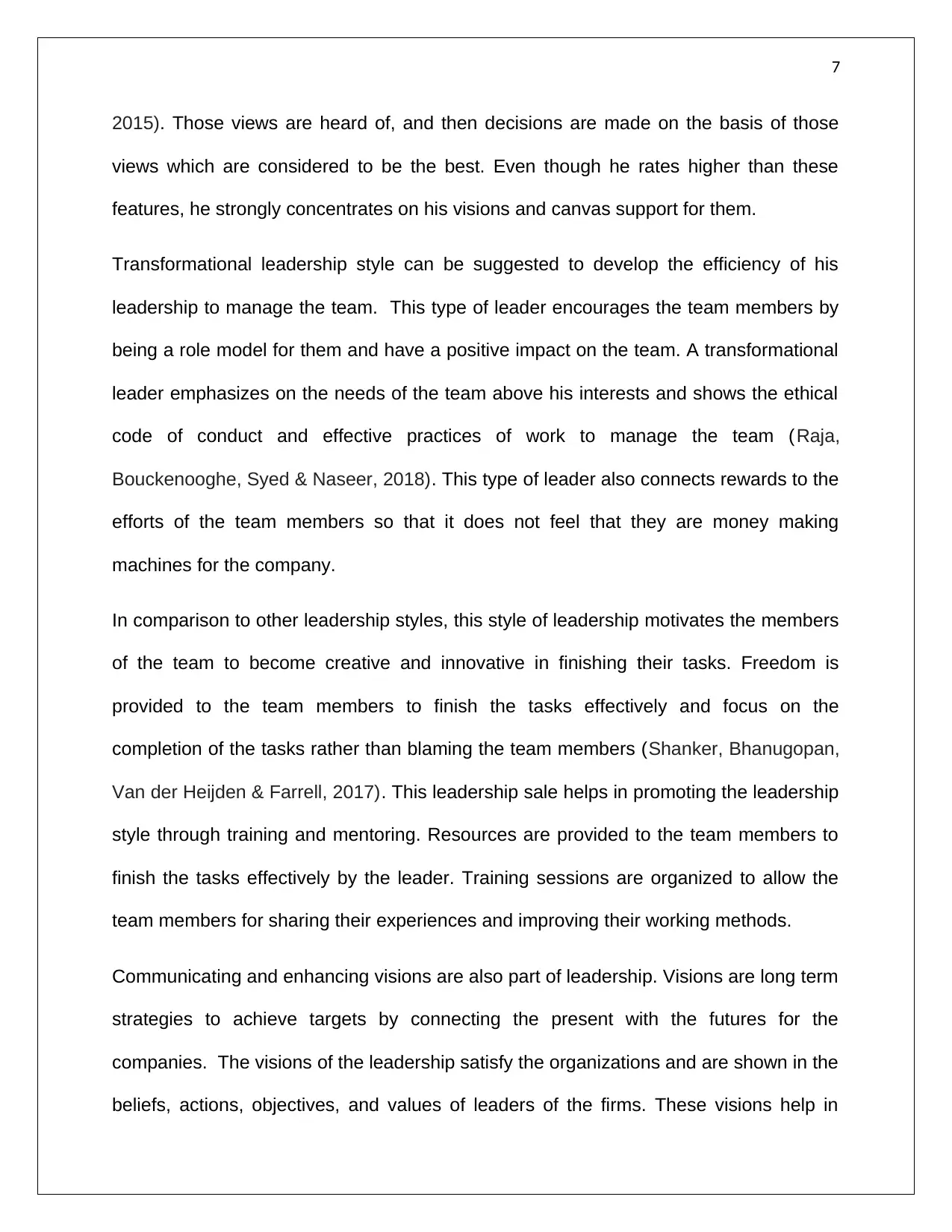
7
2015). Those views are heard of, and then decisions are made on the basis of those
views which are considered to be the best. Even though he rates higher than these
features, he strongly concentrates on his visions and canvas support for them.
Transformational leadership style can be suggested to develop the efficiency of his
leadership to manage the team. This type of leader encourages the team members by
being a role model for them and have a positive impact on the team. A transformational
leader emphasizes on the needs of the team above his interests and shows the ethical
code of conduct and effective practices of work to manage the team (Raja,
Bouckenooghe, Syed & Naseer, 2018). This type of leader also connects rewards to the
efforts of the team members so that it does not feel that they are money making
machines for the company.
In comparison to other leadership styles, this style of leadership motivates the members
of the team to become creative and innovative in finishing their tasks. Freedom is
provided to the team members to finish the tasks effectively and focus on the
completion of the tasks rather than blaming the team members (Shanker, Bhanugopan,
Van der Heijden & Farrell, 2017). This leadership sale helps in promoting the leadership
style through training and mentoring. Resources are provided to the team members to
finish the tasks effectively by the leader. Training sessions are organized to allow the
team members for sharing their experiences and improving their working methods.
Communicating and enhancing visions are also part of leadership. Visions are long term
strategies to achieve targets by connecting the present with the futures for the
companies. The visions of the leadership satisfy the organizations and are shown in the
beliefs, actions, objectives, and values of leaders of the firms. These visions help in
2015). Those views are heard of, and then decisions are made on the basis of those
views which are considered to be the best. Even though he rates higher than these
features, he strongly concentrates on his visions and canvas support for them.
Transformational leadership style can be suggested to develop the efficiency of his
leadership to manage the team. This type of leader encourages the team members by
being a role model for them and have a positive impact on the team. A transformational
leader emphasizes on the needs of the team above his interests and shows the ethical
code of conduct and effective practices of work to manage the team (Raja,
Bouckenooghe, Syed & Naseer, 2018). This type of leader also connects rewards to the
efforts of the team members so that it does not feel that they are money making
machines for the company.
In comparison to other leadership styles, this style of leadership motivates the members
of the team to become creative and innovative in finishing their tasks. Freedom is
provided to the team members to finish the tasks effectively and focus on the
completion of the tasks rather than blaming the team members (Shanker, Bhanugopan,
Van der Heijden & Farrell, 2017). This leadership sale helps in promoting the leadership
style through training and mentoring. Resources are provided to the team members to
finish the tasks effectively by the leader. Training sessions are organized to allow the
team members for sharing their experiences and improving their working methods.
Communicating and enhancing visions are also part of leadership. Visions are long term
strategies to achieve targets by connecting the present with the futures for the
companies. The visions of the leadership satisfy the organizations and are shown in the
beliefs, actions, objectives, and values of leaders of the firms. These visions help in

8
attracting and affecting all the staffs those who are involved in the beliefs, actions,
objectives, and values of leaders or the firms as they want to share the visions of the
leaders (Wang, Demerouti & Le Blanc, 2017).
Vision, at UltraTech, is a motivating aspect in connecting the commitments of a vast
number of employees, and subsequently, it affects the outcomes of the organization. At
UltraTech, there is a vast difference between the actual vision and the specified vision.
The specified vision developed at the time of change management to make the
company more inclusive and participative.
Although the senior leader supported the vision, it became evident over time that his
obligation was not strong towards the new vision, and he continued to promote and
motivate people to his actual vision. For improving the performance of the company the
vision needs to be redefined in terms of the willingness of commitments of the leader is
and to make sure that the commitments are communicated by the leaders through his
words and his actions (Saleem, 2015).
Another aspect of leadership is change management, which is the ability to bring
changes successfully. Efficient leaders study the working atmosphere continuously for
clues for potential changes and help the teams to take decisions on the responsiveness
towards the changes. At UltraTech, the leader has embraced the changes needed for
the company to flourish, but he seems to be comfortable with his actual vision (Erkutlu &
Chafra, 2018). It was evidenced when he needed a new employee for bringing new
viewpoints and fresh skills. However, he was not willing to give the responsibility to
apply the necessary changes.
attracting and affecting all the staffs those who are involved in the beliefs, actions,
objectives, and values of leaders or the firms as they want to share the visions of the
leaders (Wang, Demerouti & Le Blanc, 2017).
Vision, at UltraTech, is a motivating aspect in connecting the commitments of a vast
number of employees, and subsequently, it affects the outcomes of the organization. At
UltraTech, there is a vast difference between the actual vision and the specified vision.
The specified vision developed at the time of change management to make the
company more inclusive and participative.
Although the senior leader supported the vision, it became evident over time that his
obligation was not strong towards the new vision, and he continued to promote and
motivate people to his actual vision. For improving the performance of the company the
vision needs to be redefined in terms of the willingness of commitments of the leader is
and to make sure that the commitments are communicated by the leaders through his
words and his actions (Saleem, 2015).
Another aspect of leadership is change management, which is the ability to bring
changes successfully. Efficient leaders study the working atmosphere continuously for
clues for potential changes and help the teams to take decisions on the responsiveness
towards the changes. At UltraTech, the leader has embraced the changes needed for
the company to flourish, but he seems to be comfortable with his actual vision (Erkutlu &
Chafra, 2018). It was evidenced when he needed a new employee for bringing new
viewpoints and fresh skills. However, he was not willing to give the responsibility to
apply the necessary changes.
⊘ This is a preview!⊘
Do you want full access?
Subscribe today to unlock all pages.

Trusted by 1+ million students worldwide
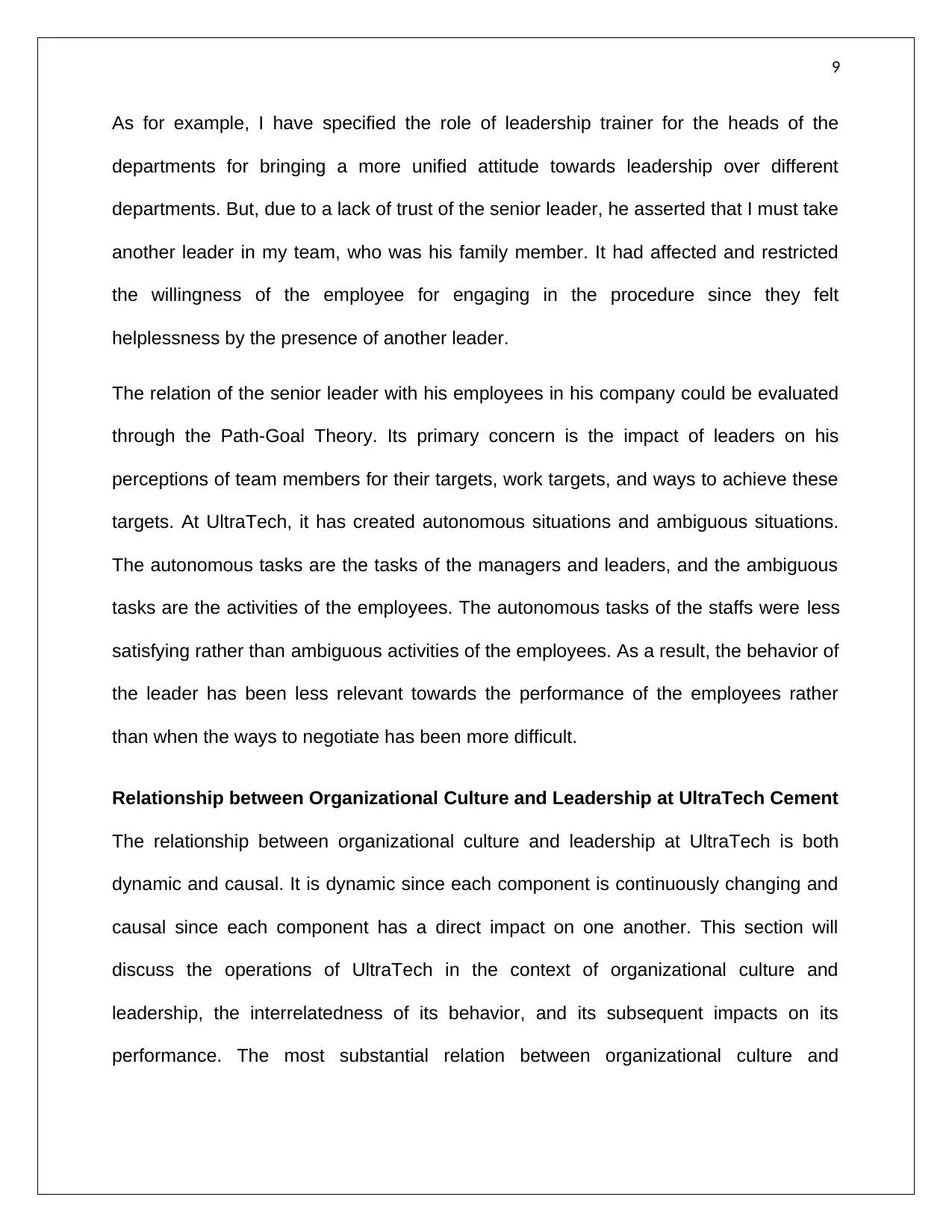
9
As for example, I have specified the role of leadership trainer for the heads of the
departments for bringing a more unified attitude towards leadership over different
departments. But, due to a lack of trust of the senior leader, he asserted that I must take
another leader in my team, who was his family member. It had affected and restricted
the willingness of the employee for engaging in the procedure since they felt
helplessness by the presence of another leader.
The relation of the senior leader with his employees in his company could be evaluated
through the Path-Goal Theory. Its primary concern is the impact of leaders on his
perceptions of team members for their targets, work targets, and ways to achieve these
targets. At UltraTech, it has created autonomous situations and ambiguous situations.
The autonomous tasks are the tasks of the managers and leaders, and the ambiguous
tasks are the activities of the employees. The autonomous tasks of the staffs were less
satisfying rather than ambiguous activities of the employees. As a result, the behavior of
the leader has been less relevant towards the performance of the employees rather
than when the ways to negotiate has been more difficult.
Relationship between Organizational Culture and Leadership at UltraTech Cement
The relationship between organizational culture and leadership at UltraTech is both
dynamic and causal. It is dynamic since each component is continuously changing and
causal since each component has a direct impact on one another. This section will
discuss the operations of UltraTech in the context of organizational culture and
leadership, the interrelatedness of its behavior, and its subsequent impacts on its
performance. The most substantial relation between organizational culture and
As for example, I have specified the role of leadership trainer for the heads of the
departments for bringing a more unified attitude towards leadership over different
departments. But, due to a lack of trust of the senior leader, he asserted that I must take
another leader in my team, who was his family member. It had affected and restricted
the willingness of the employee for engaging in the procedure since they felt
helplessness by the presence of another leader.
The relation of the senior leader with his employees in his company could be evaluated
through the Path-Goal Theory. Its primary concern is the impact of leaders on his
perceptions of team members for their targets, work targets, and ways to achieve these
targets. At UltraTech, it has created autonomous situations and ambiguous situations.
The autonomous tasks are the tasks of the managers and leaders, and the ambiguous
tasks are the activities of the employees. The autonomous tasks of the staffs were less
satisfying rather than ambiguous activities of the employees. As a result, the behavior of
the leader has been less relevant towards the performance of the employees rather
than when the ways to negotiate has been more difficult.
Relationship between Organizational Culture and Leadership at UltraTech Cement
The relationship between organizational culture and leadership at UltraTech is both
dynamic and causal. It is dynamic since each component is continuously changing and
causal since each component has a direct impact on one another. This section will
discuss the operations of UltraTech in the context of organizational culture and
leadership, the interrelatedness of its behavior, and its subsequent impacts on its
performance. The most substantial relation between organizational culture and
Paraphrase This Document
Need a fresh take? Get an instant paraphrase of this document with our AI Paraphraser
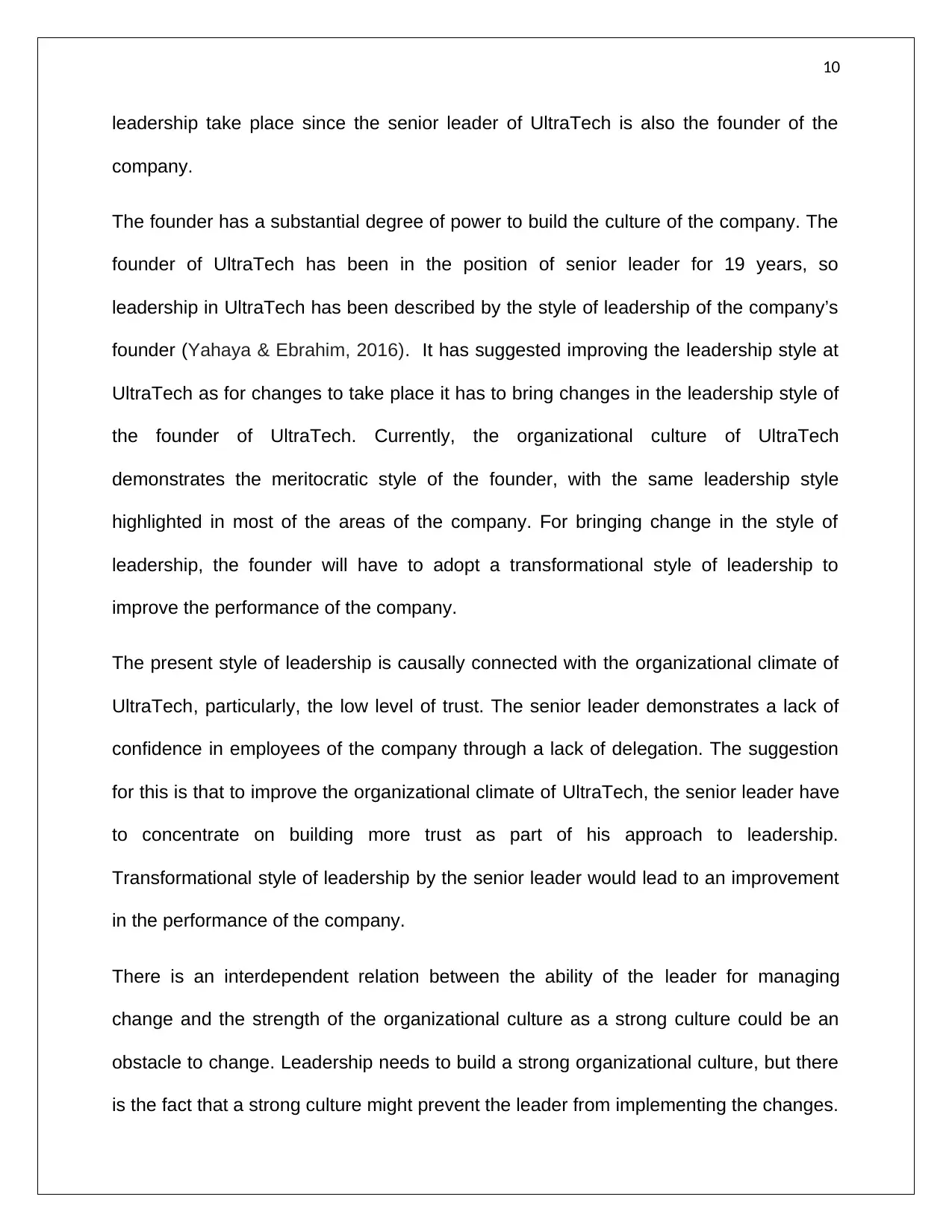
10
leadership take place since the senior leader of UltraTech is also the founder of the
company.
The founder has a substantial degree of power to build the culture of the company. The
founder of UltraTech has been in the position of senior leader for 19 years, so
leadership in UltraTech has been described by the style of leadership of the company’s
founder (Yahaya & Ebrahim, 2016). It has suggested improving the leadership style at
UltraTech as for changes to take place it has to bring changes in the leadership style of
the founder of UltraTech. Currently, the organizational culture of UltraTech
demonstrates the meritocratic style of the founder, with the same leadership style
highlighted in most of the areas of the company. For bringing change in the style of
leadership, the founder will have to adopt a transformational style of leadership to
improve the performance of the company.
The present style of leadership is causally connected with the organizational climate of
UltraTech, particularly, the low level of trust. The senior leader demonstrates a lack of
confidence in employees of the company through a lack of delegation. The suggestion
for this is that to improve the organizational climate of UltraTech, the senior leader have
to concentrate on building more trust as part of his approach to leadership.
Transformational style of leadership by the senior leader would lead to an improvement
in the performance of the company.
There is an interdependent relation between the ability of the leader for managing
change and the strength of the organizational culture as a strong culture could be an
obstacle to change. Leadership needs to build a strong organizational culture, but there
is the fact that a strong culture might prevent the leader from implementing the changes.
leadership take place since the senior leader of UltraTech is also the founder of the
company.
The founder has a substantial degree of power to build the culture of the company. The
founder of UltraTech has been in the position of senior leader for 19 years, so
leadership in UltraTech has been described by the style of leadership of the company’s
founder (Yahaya & Ebrahim, 2016). It has suggested improving the leadership style at
UltraTech as for changes to take place it has to bring changes in the leadership style of
the founder of UltraTech. Currently, the organizational culture of UltraTech
demonstrates the meritocratic style of the founder, with the same leadership style
highlighted in most of the areas of the company. For bringing change in the style of
leadership, the founder will have to adopt a transformational style of leadership to
improve the performance of the company.
The present style of leadership is causally connected with the organizational climate of
UltraTech, particularly, the low level of trust. The senior leader demonstrates a lack of
confidence in employees of the company through a lack of delegation. The suggestion
for this is that to improve the organizational climate of UltraTech, the senior leader have
to concentrate on building more trust as part of his approach to leadership.
Transformational style of leadership by the senior leader would lead to an improvement
in the performance of the company.
There is an interdependent relation between the ability of the leader for managing
change and the strength of the organizational culture as a strong culture could be an
obstacle to change. Leadership needs to build a strong organizational culture, but there
is the fact that a strong culture might prevent the leader from implementing the changes.
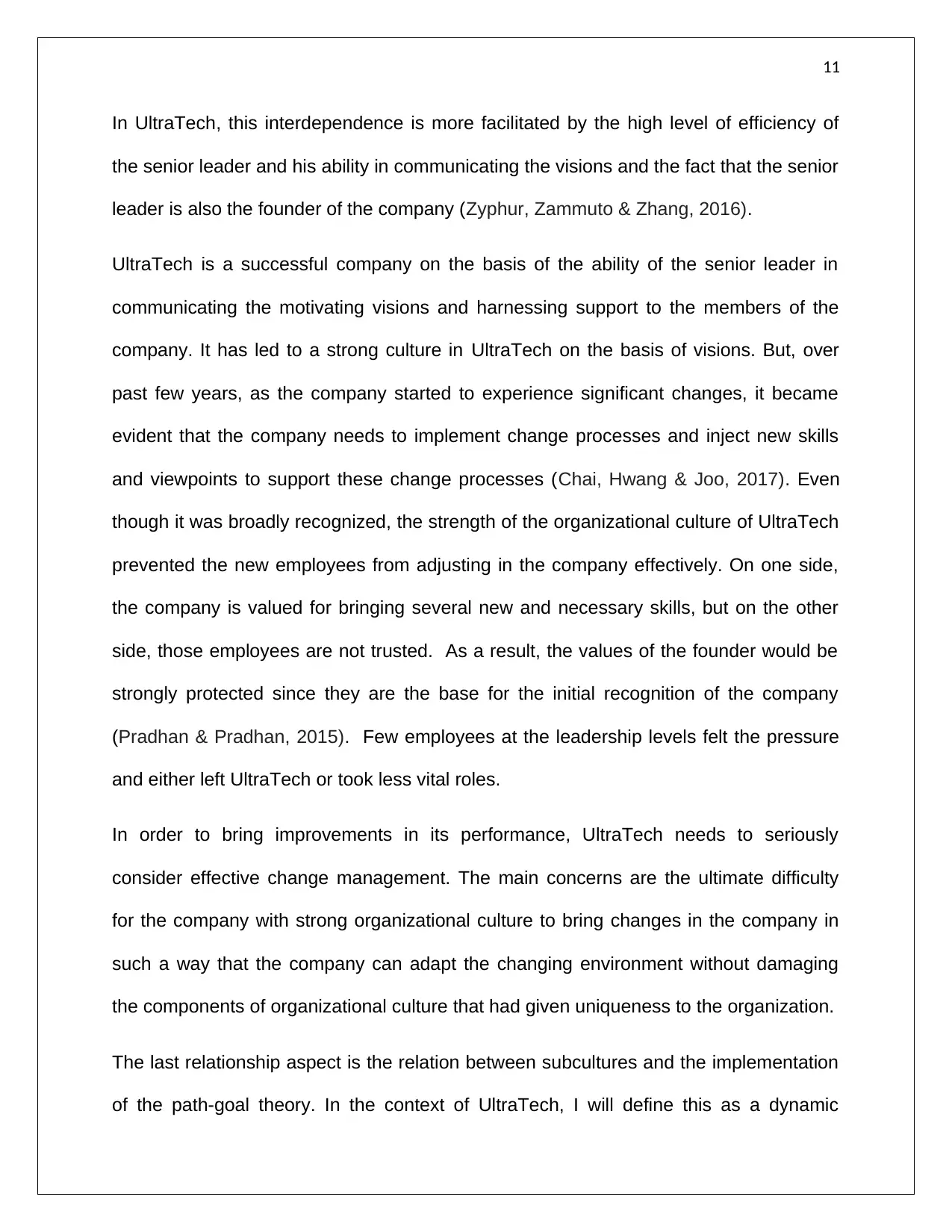
11
In UltraTech, this interdependence is more facilitated by the high level of efficiency of
the senior leader and his ability in communicating the visions and the fact that the senior
leader is also the founder of the company (Zyphur, Zammuto & Zhang, 2016).
UltraTech is a successful company on the basis of the ability of the senior leader in
communicating the motivating visions and harnessing support to the members of the
company. It has led to a strong culture in UltraTech on the basis of visions. But, over
past few years, as the company started to experience significant changes, it became
evident that the company needs to implement change processes and inject new skills
and viewpoints to support these change processes (Chai, Hwang & Joo, 2017). Even
though it was broadly recognized, the strength of the organizational culture of UltraTech
prevented the new employees from adjusting in the company effectively. On one side,
the company is valued for bringing several new and necessary skills, but on the other
side, those employees are not trusted. As a result, the values of the founder would be
strongly protected since they are the base for the initial recognition of the company
(Pradhan & Pradhan, 2015). Few employees at the leadership levels felt the pressure
and either left UltraTech or took less vital roles.
In order to bring improvements in its performance, UltraTech needs to seriously
consider effective change management. The main concerns are the ultimate difficulty
for the company with strong organizational culture to bring changes in the company in
such a way that the company can adapt the changing environment without damaging
the components of organizational culture that had given uniqueness to the organization.
The last relationship aspect is the relation between subcultures and the implementation
of the path-goal theory. In the context of UltraTech, I will define this as a dynamic
In UltraTech, this interdependence is more facilitated by the high level of efficiency of
the senior leader and his ability in communicating the visions and the fact that the senior
leader is also the founder of the company (Zyphur, Zammuto & Zhang, 2016).
UltraTech is a successful company on the basis of the ability of the senior leader in
communicating the motivating visions and harnessing support to the members of the
company. It has led to a strong culture in UltraTech on the basis of visions. But, over
past few years, as the company started to experience significant changes, it became
evident that the company needs to implement change processes and inject new skills
and viewpoints to support these change processes (Chai, Hwang & Joo, 2017). Even
though it was broadly recognized, the strength of the organizational culture of UltraTech
prevented the new employees from adjusting in the company effectively. On one side,
the company is valued for bringing several new and necessary skills, but on the other
side, those employees are not trusted. As a result, the values of the founder would be
strongly protected since they are the base for the initial recognition of the company
(Pradhan & Pradhan, 2015). Few employees at the leadership levels felt the pressure
and either left UltraTech or took less vital roles.
In order to bring improvements in its performance, UltraTech needs to seriously
consider effective change management. The main concerns are the ultimate difficulty
for the company with strong organizational culture to bring changes in the company in
such a way that the company can adapt the changing environment without damaging
the components of organizational culture that had given uniqueness to the organization.
The last relationship aspect is the relation between subcultures and the implementation
of the path-goal theory. In the context of UltraTech, I will define this as a dynamic
⊘ This is a preview!⊘
Do you want full access?
Subscribe today to unlock all pages.

Trusted by 1+ million students worldwide
1 out of 17